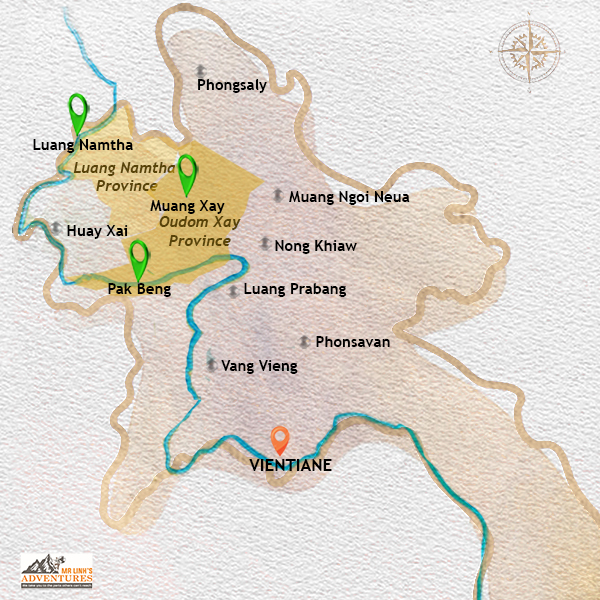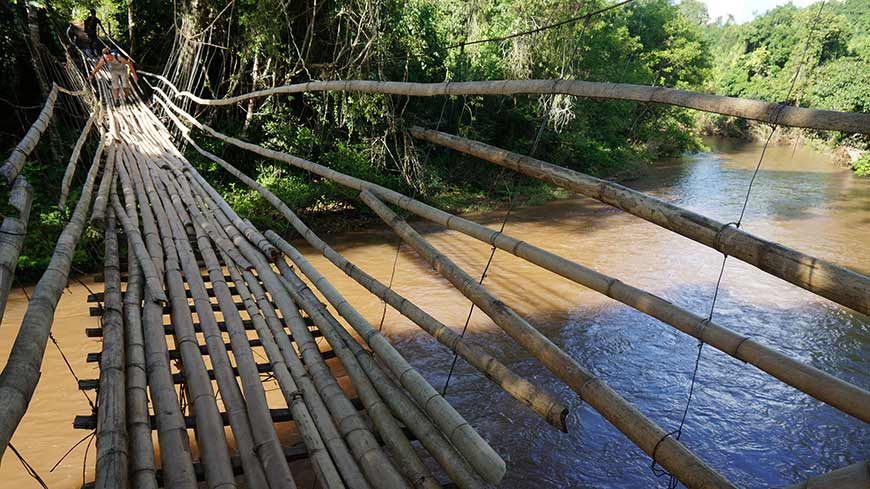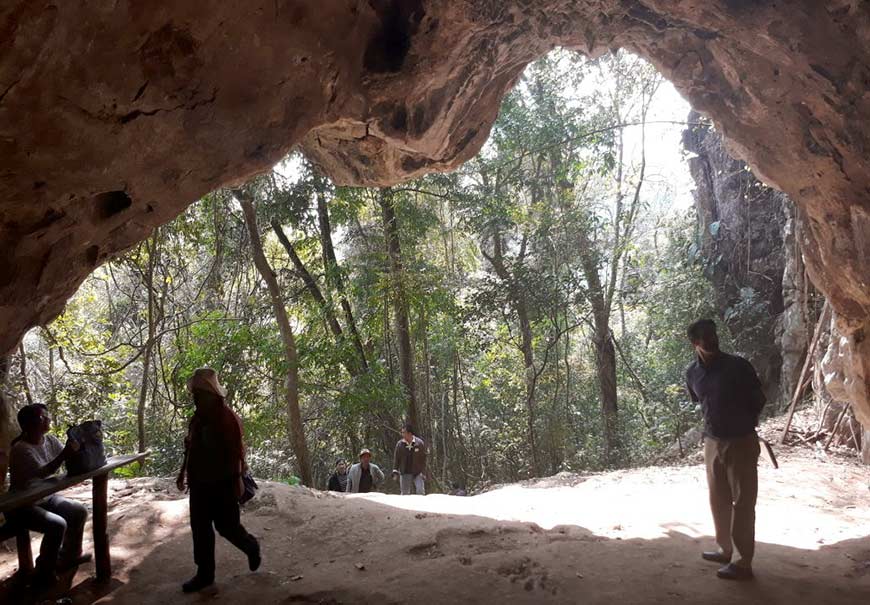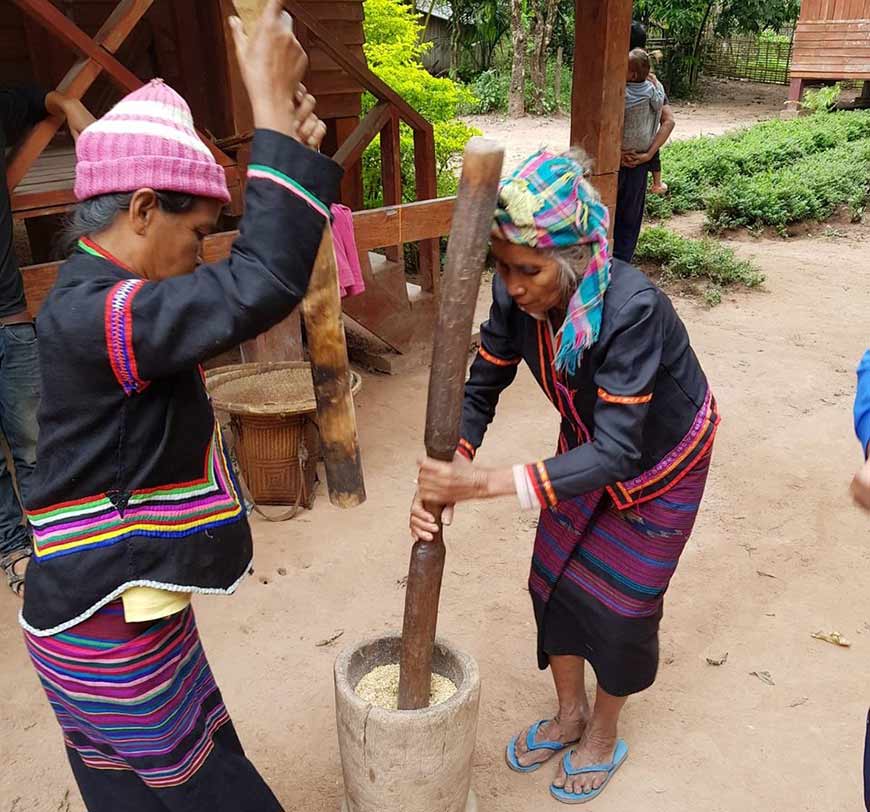 Overview
Overview

While
Oudomxay is less visited than other Laotian destinations, this preserved land captivates with its grand landscapes and the cultural richness of its inhabitants, especially the Khmu and Hmong ethnic groups.
Further north,
Luang Namtha stands out as a top destination for lovers of authenticity. The Nam Ha National Park, a true natural gem, offers endless hiking opportunities in the spirit of responsible tourism. The surrounding villages, particularly around Muang Sing, provide privileged encounters with local populations.
The town also serves as the only land crossing point to China open to foreigners.
 Top Attractions
Top Attractions

North-western Laos is properly off the beaten track
Oudomxay
While Oudomxay is often seen as a mere stopover on the road connecting Luang Prabang to Luang Namtha, it proves to be a worthwhile destination for those wishing to explore the ethnic hinterland by 4x4 or indulge in a few days of trekking. The Chom Ong Caves constitute its main attraction, impressive for their sometimes gargantuan dimensions, reaching up to 40 meters in height, and their ancient stalactites that plunge into the immensity of the cavities.
Luang Namtha
Luang Namtha, the peaceful capital of its province, is a favored stop for travelers eager to discover the natural riches of northwestern Laos.
The Luang Namtha region, a true land of adventure with exceptional natural and cultural wealth, stands out for its ethnic diversity, unique in Laos. Its mountainous terrain is home to nearly forty different ethnic groups, from the Hmong to the Thai families, including the Akha, Yao, and Lao Loum.
Ecotourism has developed naturally here, with a focus on preserving the beauty of the landscapes and the authenticity of the villages.
Nam Ha Protected Area
In the heart of the splendid Nam Ha Protected Area, a wide range of activities is offered: trekking, rafting, cycling tourism, kayaking, or boat trips down the Nam Ha River to the Mekong. These excursions, organized from Luang Namtha or Muang Sing, offer the opportunity to interact with local populations and even share their daily lives by spending the night in homestays.
Pakbeng
Pakbeng, a charming stopover
village between Houay Xay and Luang Prabang for those traveling down the Mekong, offers breathtaking views of the river and enriching encounters at an elephant camp. This picturesque town mainly serves as a halt for tourists taking a two-day cruise between Houay Xai, on the Thai border, and Luang Prabang, thus requiring an overnight stay in one of the many guesthouses welcoming travelers.
 See & Do
See & Do

The Chom Ong Caves are the main attraction of Udomxai
In Oudomxay, travelers will discover with delight the Muang La hot springs, a true haven of peace nestled in the heart of a mountainous setting. This natural sanctuary invites relaxation and serenity after a day dedicated to exploration.
Immersion within the ethnic minority villages of Oudomxay reveals a privileged window into the rich Laotian culture. These communities authentically unveil their ancestral ways of life, delicate crafts, and age-old traditions, thus offering human encounters of rare depth. This cultural exploration forms an essential part of any discovery of northern Laos.
About forty kilometers away, the Chom Ong Cave reveals its impressive underground galleries, gracefully winding along the Nam Kaeng River.
The Luang Namtha region captivates with the splendor of its landscapes and the diversity of its outdoor activities: trekking, rafting, hiking, and cycling are all available to adventurers. The easily accessible Nam Dee Waterfall and the Kao Rao Cave, with its unique rock formations, deserve particular attention.
The surrounding ethnic villages, such as those of the Akha, Hmong, and Tai Dam, offer a unique opportunity to immerse oneself in the culture and traditional way of life of the Laotian minorities.
Luang Namtha also boasts a rich historical heritage, testifying to the influence of neighboring kingdoms. Its Buddhist temples, like Wat Sing Jai, are true architectural gems inviting contemplation.
Finally, adventure reaches its peak in the heart of Nam Kan National Park with the famous "Gibbon Experience." There, at the top of the lush canopy, are nestled the legendary treehouses connected by dizzying zip lines. This unique ecotourism project harmoniously blends adventure and nature. Visitors to this part of Southeast Asia will see their childhood dreams come true by waking up with the sunrise in a fairytale refuge, before soaring through the forest, gliding from tree to tree for a unique perspective.
 Go Green
Go Green
Mr Linh's Adventures, a local travel agency specializing in adventure and discovery tours, offers tailor-made itineraries in the Muang Ngoi district:
- • Trekking and discovery of ethnic villages: Meet the local ethnic minorities, share their daily life and discover their culture and traditions.
- • Exploration of caves and waterfalls: Venture into the depths of the Tham Pha Thok caves and refresh yourself in the hidden waterfalls.
- • Hiking and kayaking on the Ou River: Combine hiking and kayaking for a unique experience in the heart of Lao nature.
 Heritage
Heritage
The Phu That Stupa is an imposing sight
In Oudomxay, the local museum serves as a relevant introduction to the ancestral culture and customs. While part of its collection is dedicated to communist propaganda, it also offers a fascinating glimpse into ethnic costumes and traditional rural tools.
A thriving town, Oudomxay vibrates to the rhythm of trade between Laos and neighboring China, a palpable reality as soon as one strolls along its main street. Mandarin signs dot the urban landscape, and the significance of the Chinese community, representing nearly a quarter of the population, gives the Yunnanese dialect an almost equivalent presence to Lao.
A visit to the Phu That Stupa, the setting for religious ceremonies at each full moon, is a must, as is the discovery of Wat Phu That, a charming temple perched on a hill offering a welcome breeze. The Banjeng Temple, the province's most significant monastery, for its part, features a unique "tree of life" made of concrete and metal.
About twenty kilometers from Oudomxay, on the road to Phongsali, Muang La is home to the most revered Buddha statue in northern Laos: the famous Pra Singkham Buddha. Local legend tells of its creation in Sri Lanka shortly after the Buddha's death, and its journey to Laos in 838 AD, where it found refuge in the Singkham Cave. Although the cave can still be visited, it now houses a replica, as the original statue was moved in 1457 to a temple specifically erected for it. Local tradition attributes to this Buddha the power to grant wishes.
The region bears witness to a rich heritage, from ethnographic museums to traditional villages such as Ban Nam Di, guardian of Lao Huay traditions. Muang Sing captivates with its elegant French-Laotian colonial houses dating from the 1920s.
Oudomxay province is a true melting pot of cultures, home to a mosaic of ethnic groups among which the Khmu, Hmong, and Lao are the most numerous. This diversity contributes to the cultural richness of the region, often perceived as a commercial crossroads where traditions intertwine. The population of Oudomxay is predominantly composed of Lao Theung and Lao Sung (around 60%), while the Chinese and Lao Loum communities represent 25% and 15% respectively. Luang Namtha, for its part, is renowned for harboring the largest number of ethnic minorities in Laos, with estimates varying between 21 and 43 groups according to sources. Among these, the Khmu (around 25% of the population), the Akha, Tai Leu, Hmong, and Yao are particularly distinguished by their unique culture and ancestral agricultural practices.
 Local women hard at work
Local women hard at work
Ban Akha: Famous for the vibrancy of its costumes.
Ban Khmu: An immersion in the heart of age-old agricultural traditions.
Ban Tai Lue: An authentic glimpse into traditional housing.
Ban Lanten: Renowned for its delicate paper crafts.
Ban Hmong: A window into rice cultivation and refined textile art.
 Food & Drinks
Food & Drinks
A typical meal in north-western Laos.
In Oudomxay, savor Khao Soi, a generously spiced curried noodle soup; Tam Mak Houng, a zesty green papaya salad; or the delicate Mok Pa, fragrant fish steamed in banana leaf parcels.
Luang Namtha delights with its Or Lam, a traditional aromatic herb stew; Khao Poun, a coconut milk noodle soup; and for the more adventurous, Kaipen, crispy river weed served as an appetizer. It's also possible to sample various ethnic dishes from the Khamu, Tai Dam, and Akha peoples.
 Directions
Directions
Access from Vientiane is mainly by train (2h33-3h, 20-50 USD) or bus (14-18h, 170,000-190,000 kip) to Oudomxay. For Luang Namtha, expect about 22 hours by bus (140,000 kip).
The ideal time to visit is from November to April, during the dry season, offering optimal conditions to explore this enchanting region.